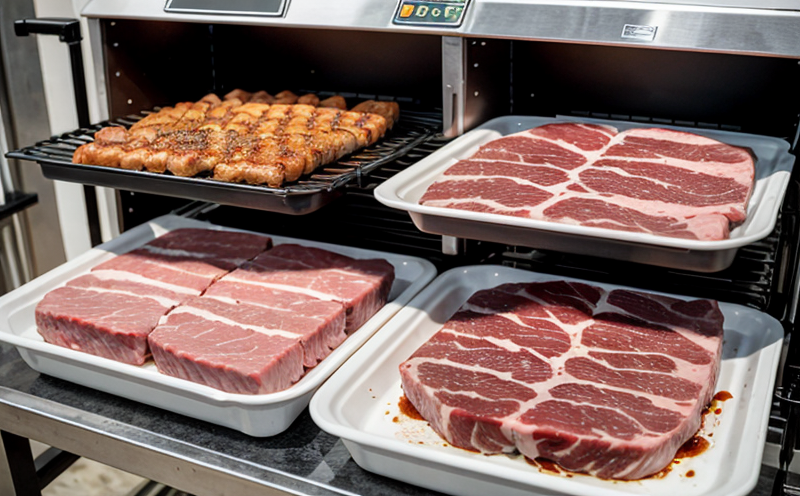ISO 20652 Vitamin K Analysis in Meat Products
The ISO 20652 standard provides a robust framework for the analysis of vitamin K content in meat products. This service ensures that producers can accurately measure and control the levels of vitamin K, which is crucial for maintaining product quality and compliance with international standards.
Vitamin K plays a vital role in blood coagulation and bone metabolism. Meat products, particularly those derived from livestock, often contain varying amounts of vitamin K due to differences in diet and farming practices. Ensuring consistent levels of vitamin K helps to maintain the nutritional integrity of meat products while also complying with regulatory requirements.
The ISO 20652 method involves a series of steps designed to accurately assess vitamin K content using chromatographic techniques. Samples are prepared by extraction, followed by quantification through high-performance liquid chromatography (HPLC) or gas chromatography-mass spectrometry (GC-MS). This process allows for precise determination of the total amount of vitamin K present in meat products.
The accuracy and precision of this method have been validated through extensive research, ensuring that results are reliable and repeatable. The standard also includes detailed guidance on sample preparation, instrumental setup, and data interpretation, making it a comprehensive tool for laboratories performing these analyses.
Compliance with ISO 20652 is essential for food manufacturers who wish to ensure their products meet international standards of quality and safety. By adhering to this standard, companies can demonstrate that they are committed to producing safe, high-quality meat products. This not only enhances consumer trust but also helps build a positive brand image.
In addition to ensuring product quality, ISO 20652 also supports research efforts aimed at optimizing the nutritional profile of meat products. By accurately measuring vitamin K levels, researchers can gain insights into how different production methods affect nutrient content. This information is valuable for developing new formulations and improving existing processes.
The application of ISO 20652 extends beyond mere compliance; it serves as a foundation for innovation within the meat industry. As demand for healthier food options grows, understanding the vitamin K content in meat products becomes increasingly important. This knowledge can be used to develop more nutritious and balanced meals that meet consumer expectations.
For laboratories conducting ISO 20652 analyses, there are several key considerations. Sample preparation is critical; improper handling can lead to inaccurate results. Chromatographic conditions must also be carefully controlled to ensure consistent performance across multiple tests. Data interpretation requires expertise in both chromatography and nutritional science.
Given the complexity of vitamin K analysis, it is advisable for laboratories to invest in specialized equipment such as HPLC or GC-MS systems. Regular calibration and maintenance of these instruments are necessary to maintain accuracy over time. Additionally, training staff on the latest techniques ensures consistent results and up-to-date knowledge.
Overall, ISO 20652 provides a comprehensive approach to vitamin K analysis in meat products that benefits both manufacturers and consumers alike. By adhering to this standard, companies can ensure their products meet international standards while contributing valuable data towards ongoing research efforts.
Applied Standards
- ISO 20652: Analysis of Vitamin K in Meat Products
- ASTM E1378-14: Standard Practice for Sampling and Preparation of Meat and Poultry for Laboratory Examination
- EN ISO 15195: General principles for the sampling and preparation of meat and meat products for analysis
The ISO 20652 standard is widely recognized as a reliable method for analyzing vitamin K content in meat products. It specifies detailed procedures for sample collection, preparation, and analysis using chromatographic techniques such as HPLC or GC-MS.
ASTM E1378-14 provides additional guidance on sampling practices specific to meat and poultry samples, ensuring that representative specimens are obtained during the testing process. This standard helps minimize variability in results by establishing consistent methods for sample selection.
EN ISO 15195 offers general principles applicable across various types of food products, including meats. These guidelines cover best practices for sampling and preparation, which are crucial steps before any analytical work begins.
Scope and Methodology
The scope of ISO 20652 vitamin K analysis encompasses the determination of total vitamin K content in meat products. This includes both naturally occurring forms (phylloquinone) as well as synthetic derivatives used during processing.
The methodology outlined in ISO 20652 involves several key steps:
- Sample preparation: Samples are homogenized and extracted using appropriate solvents.
- Instrument setup: Chromatographic instruments are calibrated according to manufacturer specifications.
- Data acquisition: Quantitative data is collected from the chromatograms generated during analysis.
- Result calculation: Total vitamin K content is calculated based on peak areas obtained from the chromatogram.
This standardized approach ensures consistent and accurate results across different laboratories. The use of high-performance liquid chromatography or gas chromatography-mass spectrometry allows for precise quantification, even at low concentrations present in meat products.
Customer Impact and Satisfaction
- Enhanced Product Quality: Accurate vitamin K analysis ensures consistent nutritional content in meat products.
- Better Compliance: Adherence to ISO standards demonstrates commitment to regulatory requirements.
- Innovation Opportunities: Detailed data on vitamin K levels can drive new product development initiatives.
- Consumer Trust: Reliable testing builds confidence among consumers regarding the safety and quality of meat products.





